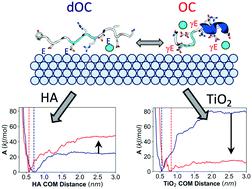当前位置:
X-MOL 学术
›
Mol. Syst. Des. Eng.
›
论文详情
Our official English website, www.x-mol.net, welcomes your feedback! (Note: you will need to create a separate account there.)
Impact of glutamate carboxylation in the adsorption of the α-1 domain of osteocalcin to hydroxyapatite and titania
Molecular Systems Design & Engineering ( IF 3.6 ) Pub Date : 2019-12-09 , DOI: 10.1039/c9me00158a Sarah Alamdari 1 , Jim Pfaendtner 1
Molecular Systems Design & Engineering ( IF 3.6 ) Pub Date : 2019-12-09 , DOI: 10.1039/c9me00158a Sarah Alamdari 1 , Jim Pfaendtner 1
Affiliation

|
One proposed mechanism of implant fouling is attributed to the nonspecific adsorption of non-collagenous bone matrix proteins (NCPs) onto a newly implanted interface. With the goal of capturing the fundamental mechanistic and thermodynamic forces that govern changes in these NCP recognition domains as a function of γ-carboxyglutamic acid (Gla) post-translational modification and surface chemistry, we probe the adsorption process of the most commonly occurring NCP, osteocalcin, onto a mineral and metal oxide surface. Here, we apply two enhanced sampling methods to independently probe the effects of post-translational modification and peptide structure on adsorption. First, well-tempered metadynamics was used to capture the binding of acetyl and N-methylamide capped glutamic acid and Gla single amino acids onto crystalline hydroxyapatite and titania model surfaces at physiological pH. Following this, parallel tempering metadynamics in the well-tempered ensemble (PTMetaD-WTE) was used to study adsorption of the α-1 domain of osteocalcin onto hydroxyapatite and titania. Simulations were performed for the α-1 domain of osteocalcin in both its fully decarboxylated (dOC) and fully carboxylated (OC) form. Our simulations find that increased charge density due to carboxylation results in increased interactions at the interface, and stronger adsorption of the single amino acids to both surfaces. Interestingly, the role of Gla in promoting compact and helical structure in the α-1 domain resulted in disparate binding modes at the two surfaces, which is attributed to differences in interfacial water behavior. Overall, this work provides a benchmark for understanding the mechanisms that drive adsorption of Gla-containing mineralizing proteins onto different surface chemistries.
中文翻译:

谷氨酸羧化对骨钙素α-1结构域对羟基磷灰石和二氧化钛吸附的影响
一种提出的植入物污染机制归因于非胶原骨基质蛋白(NCP)在新植入界面上的非特异性吸附。为了捕获控制这些 NCP 识别域变化的基本机械力和热力学力(作为 γ-羧基谷氨酸 (Gla) 翻译后修饰和表面化学的函数),我们探讨了最常见的 NCP 的吸附过程,骨钙素附着在矿物质和金属氧化物表面上。在这里,我们应用两种增强采样方法来独立探讨翻译后修饰和肽结构对吸附的影响。首先,使用调和的元动力学来捕获乙酰基和N-甲基酰胺封端的谷氨酸和 Gla 单一氨基酸在生理 pH 下与结晶羟基磷灰石和二氧化钛模型表面的结合。此后,使用良好回火系综(PTMetaD-WTE)中的平行回火元动力学来研究骨钙素的α-1结构域在羟基磷灰石和二氧化钛上的吸附。对完全脱羧 (dOC) 和完全羧化 (OC) 形式的骨钙素的 α-1 结构域进行了模拟。我们的模拟发现,由于羧化而增加的电荷密度导致界面处的相互作用增加,并且单个氨基酸对两个表面的吸附更强。有趣的是,Gla 在促进 α-1 结构域紧凑和螺旋结构中的作用导致两个表面的结合模式不同,这归因于界面水行为的差异。总的来说,这项工作为理解驱动含 Gla 矿化蛋白吸附到不同表面化学物质上的机制提供了基准。
更新日期:2019-12-09
中文翻译:

谷氨酸羧化对骨钙素α-1结构域对羟基磷灰石和二氧化钛吸附的影响
一种提出的植入物污染机制归因于非胶原骨基质蛋白(NCP)在新植入界面上的非特异性吸附。为了捕获控制这些 NCP 识别域变化的基本机械力和热力学力(作为 γ-羧基谷氨酸 (Gla) 翻译后修饰和表面化学的函数),我们探讨了最常见的 NCP 的吸附过程,骨钙素附着在矿物质和金属氧化物表面上。在这里,我们应用两种增强采样方法来独立探讨翻译后修饰和肽结构对吸附的影响。首先,使用调和的元动力学来捕获乙酰基和N-甲基酰胺封端的谷氨酸和 Gla 单一氨基酸在生理 pH 下与结晶羟基磷灰石和二氧化钛模型表面的结合。此后,使用良好回火系综(PTMetaD-WTE)中的平行回火元动力学来研究骨钙素的α-1结构域在羟基磷灰石和二氧化钛上的吸附。对完全脱羧 (dOC) 和完全羧化 (OC) 形式的骨钙素的 α-1 结构域进行了模拟。我们的模拟发现,由于羧化而增加的电荷密度导致界面处的相互作用增加,并且单个氨基酸对两个表面的吸附更强。有趣的是,Gla 在促进 α-1 结构域紧凑和螺旋结构中的作用导致两个表面的结合模式不同,这归因于界面水行为的差异。总的来说,这项工作为理解驱动含 Gla 矿化蛋白吸附到不同表面化学物质上的机制提供了基准。



























 京公网安备 11010802027423号
京公网安备 11010802027423号